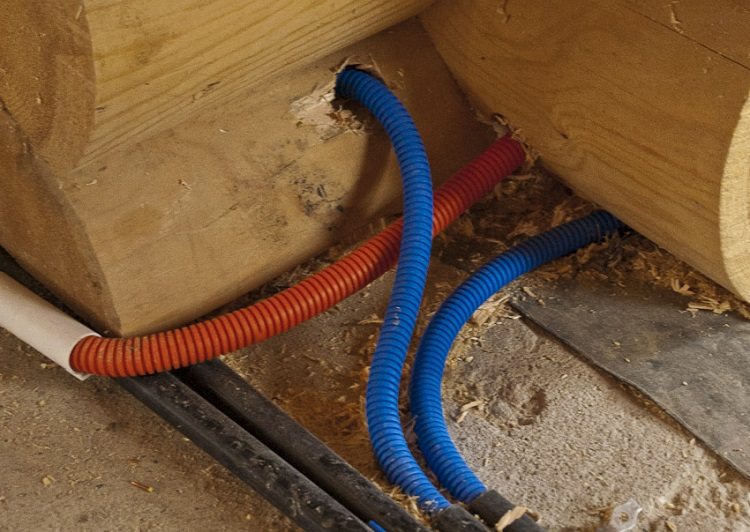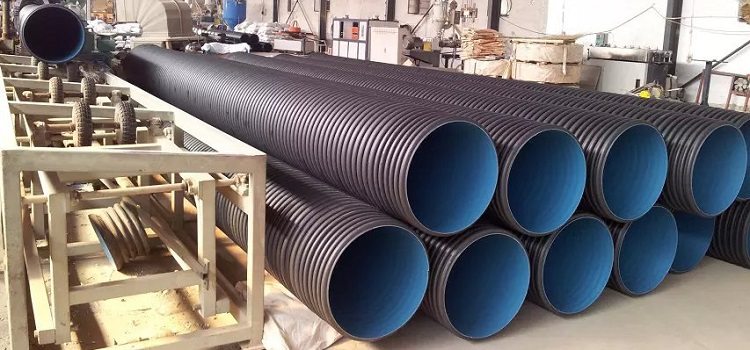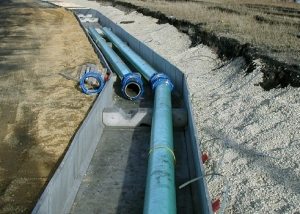Wiring is a very important part of the communications that take place indoors. Its reliable protection and the correct selection of materials for concealing wires and cables is a guarantee of safety and durability. Often, corrugated polymer products are often used as lead channels. Such pipes are manufactured according to GOST, have all the required characteristics and provide adequate protection.
Content
Product standardization
Until 2014, corrugated electrical pipes were produced in accordance with GOST 50827 from 1995. To date, the main regulatory document for products is GOST 32126.1 from 2013. Many manufacturers in the production of pipes for this purpose use the technical conditions that determine the main characteristics of the products and do not contradict GOSTs.
Corrugated pipe can be made of non-combustible low-pressure polyethylene or polyvinyl chloride. In the bay there can be 15, 25, 100, 20 or 50 meters of communications.
Note! The pipe is able to maintain its characteristics in dusty, contaminated, as well as wet rooms for a long time.
The dimensions of PVC products are given in the table.
Table 1
| Inner Diameter * 10 mm | Outer diameter * 102 mm | The length of the pipe in the bay, m |
| 1,07 | 0,16 | 100 or 50 |
| 1,41 | 0,20 | 100 or 50 |
| 1,83 | 0,25 | 50 or 25 |
| 2,43 | 0,32 | 50 or 25 |
| 3,25 | 0,40 | 20 |
| 3,96 | 0,50 | 15 |
| 5,06 | 0,63 | 15 |
Corrugated Pipe Properties
GOST defines the production of an electrical pipe from a non-combustible composite. This means that in the event of a sudden wiring fire, the spread of fire will become impossible. In addition, the obtained melt contributes to the isolation of the damaged area.

Due to the property of self-extinguishing, corrugated pipes made of polymers are an excellent option for laying electrical wiring in wooden houses
GOST defines the production of an electrical pipe from a non-combustible composite. This means that in the event of a sudden wiring fire, the spread of fire will become impossible. In addition, the obtained melt contributes to the isolation of the damaged area.
The corrugated pipe structure gives them excellent flexibility. This property is useful if you need to make turns of the wiring. In this case, neither the cable nor the channel material itself is damaged.
PVC channels have sufficient strength and are affordable, PND - mechanical strength and resistance at low temperatures. There are also two-layer versions of such pipes in which the corrugated upper layer is made of HDPE (more durable material), and the inner one is made of LDPE. Characteristics corrugated pipe PND regulated by GOST 16338, LDPE - GOST 16337.
Communications are lightweight, therefore, do not have a significant load on the supporting structures of buildings. This feature also reduces the number of mounts that you want to use during installation. In addition, it is possible to lay corrugated pipes underground.
Advantages of HDPE or PVC pipes
Corrugated protective tube eliminates the possibility of damage to the insulation of the wire or cable from all kinds of mechanical influences. It can be used for both open and hidden wiring, for example, in the floor, ceiling or walls.

Corrugations made of PVC and HDPE can be used for hidden laying of networks - in the floor, walls, underground
Electrotechnical HDPE and polyvinyl chloride flexible products have the following main advantages:
- resistance to moisture and corrosion;
- incombustibility;
- water tightness;
- chemical inertness;
- wide range of possible operating temperatures;
- environmental Safety;
- safety of all operational qualities up to 50 years.
The most significant advantage of products is that corrugated pipes have good dielectric properties. This fact eliminates the possibility of damage during damage to the cable insulation.
Note! Such a pipe allows you to quickly troubleshoot wiring, which is located in its cavity.
Electrotechnical PVC channels provide cable protection in accordance with GOST 14254, GOST 15150 and can be equipped with a probe (GOST 9389). Such products are convenient in transportation and storage, as they are available in small bays.
PND channels and their characteristics
GOST includes information on pipes of heavy and light type. This division is due to the difference in the degrees of load on the product. A light series is usually laid in order to protect wiring or compactly lay wires (cables) on walls. Heavy corrugated pipes are extra durable due to the thickness of the walls. Such products can be mounted in concrete pouring or cement screed, underground, other places where significant loads are required from communications.

Pipes of a heavy type are most often double-walled; they are used to arrange underground networks at great depths
Products have a wide range of mounting temperatures, which is -40 - +90 degrees. The same temperatures apply to operational requirements. HDPE pipes are different in color, they are black, yellow, gray, white, blue, orange.
The value of dielectric strength is not less than 2 kV or 50 Hz in 15 minutes, insulation resistance is not less than 0.1 GΩ or 0.5 kV in 1 minute.
Features of the selection of flexible corrugated pipes
GOST regulates the basic dimensions of products. The selection of the appropriate one should be based on knowledge of the number and diameter of wires that are planned to be placed.
Note! Cable pulling may be difficult or even impossible if the empty space inside the pipe is less than half of its internal volume.
Pipes with a diameter of 1.6 cm are used for laying a telephone or alarm network, as well as connecting to lighting devices, 2 cm to sockets, switches. On the basis of corrugated products of 2-2.5 cm, a coaxial network is organized. Channels with a diameter of 2.5 cm are used to connect the junction boxes and the central distribution panel. At the same time, it is recommended to carry out a backup highway.
3.2 cm pipes are used to connect electrical switchboards. In this case, a backup trunk is also necessary. Products with large diameters are usually found when connecting between floors.

Small diameter pipes are highly flexible, so you can use them to install any branch network without the cost of swivel fittings
Double-walled corrugated products
A feature of double-walled pipes is increased rigidity. Such products are used to protect wiring and cable lines that extend underground. Due to the smoothness of the inner layer, minimal friction is ensured, which is important not only for the convenience of installation work, but also for durability of use.
Two-layer, as well as single-layer, pipes are produced with diameters of 160, 63, 90, 50, 125, 200, 110 millimeters and are delivered in bays of 100, 50 or 40 meters. Corrugated products are supplied with connecting and mounting accessories, which are represented by brackets, tees, couplings, bends, clips, terminals. Adapters are presented in sizes 75-90, 90-110, 110-125, 125-140, 140-160 and 160-200 mm.
The parameters of double-walled pipes with and without broaching are shown in the table.
table 2
| Inner Diameter * 10 mm | Outer Diameter * 10 mm | Ring stiffness, not less than, kPa |
| 4,15 | 5,0 | 13,3 |
| 5,15 | 6,3 | 13,5 |
| 6,25 | 7,5 | 10,5 |
| 7,7 | 9,0 | 6,2 |
| 9,4 | 11,0 | 8,0 |
| 10,7 | 12,0 | 5,4 |
| 12,0 | 14,0 | 5,0 |
| 13,7 | 16,0 | 6,6 |
| 17,2 | 20,0 | 6,5 |
Flexible double-walled products can be used as a cable channel up to 0.01 MV in the ground, as well as during the installation of pressureless storm sewers.

In addition to electrical networks, heavy pipes are successfully used in storm, drainage and sewer systems
Mounting Features
In the joints of straight sections of corrugated pipes, special couplings are used. Fastening to surfaces is carried out using brackets or clips that are designed for different diameter products. For channels with a size of 1.6 cm, fasteners are placed approximately every 35-40 centimeters, with a size of more than 3.2 - at least every 25 cm. The trunking is carried out in the mounting boxes.
Before starting installation work, a wiring route, attachment points and location of junction boxes are planned. The electrical pipe must be purged with compressed air. Further precisely measured length is cut off.
Note! If there is a broach, then when biting it should be fixed in order to prevent leaving the pipe cavity.
The cable is attached to the protruding end of the metal probe and extends from the opposite side of the corrugation. If there are several wires, they are pre-fixed together, and then stretched. It is better to lay the pipe with a slight slope, which will prevent the accumulation of condensate. It is also not recommended to place networks for various purposes in one channel.
Degree of protection of corrugated electrical pipes
GOST 14254 establishes the degrees of protection that shells must provide. The document presents their classification, designation, requirements, as well as modes and methods of testing and control for inspecting the shells of electrical equipment.
The degree of protection according to document 14254 is the restriction of access to hazardous elements and parts, the ingress of water and / or solid objects from the outside, which the shell provides.

The production of corrugated pipes is strictly regulated by GOST, each type of such pipe has a degree of protection IP
To indicate the degree of protection, an IP code is used, consisting of the I and II characteristic digits, an additional and an auxiliary letter.
Table 3
| Code element | Value | Description for | |
| Protect people | Equipment protection | ||
| From access to hazardous elements: | From solid objects outside: | ||
| I characteristic figure | 0 | Without protection | Without protection |
| 1 | Back of hand | Diameter over 50 mm | |
| 2 | Finger | Diameter greater than 12.5 mm | |
| 3 | Tool | Diameter greater than 2.5 mm | |
| 4 | Wire | Diameter greater than 1.0 mm | |
| 5 | Wire | Dustproof | |
| 6 | Wire | Dustproof | |
| II characteristic figure | — | From exposure to water: | |
| 0 | No protection | ||
| 1 | Vertical dropping | ||
| 2 | Drop falling (at a nominal angle of 15 degrees) | ||
| 3 | Sprinkling | ||
| 4 | Continuous spraying | ||
| 5 | Jet action | ||
| 6 | Jet action (strong) | ||
| 7 | Temporary dive (short) | ||
| 8 | Long dive | ||
| Additional letter | From access to hazardous elements: | — | |
| A | Back of hand | ||
| B | Finger | ||
| C | a tool | ||
| D | Wire | ||
| Auxiliary letter | — | Supporting information that relates to: | |
| N | High voltage devices | ||
| M | The state of movement when testing water protection | ||
| S | The state of immobility during water protection tests | ||
| W | Resistance requirements to mechanical, climatic influences and special environments | ||
Corrugated pipes made of polymers Great for protecting telephone, television, power and other networks from various external influences. Product parameters provide reliable and long-term operation of the lines.






